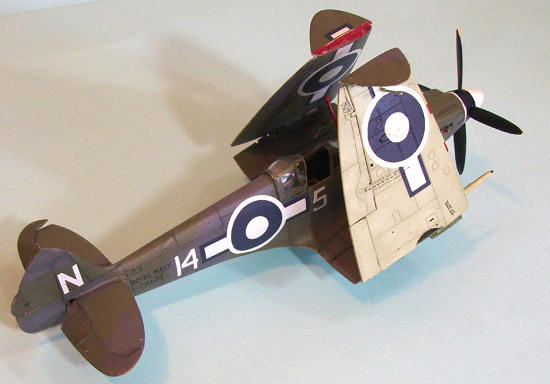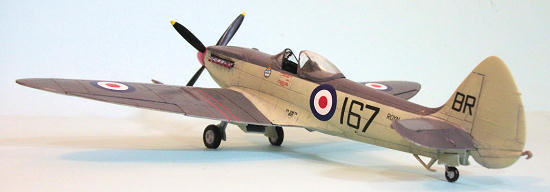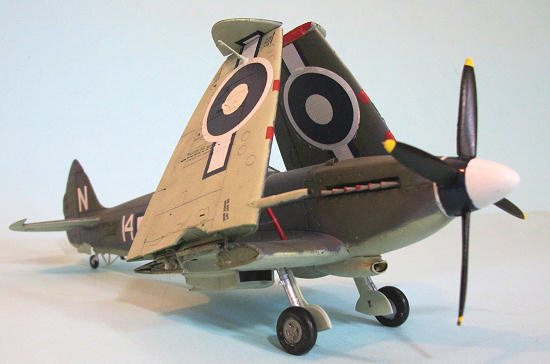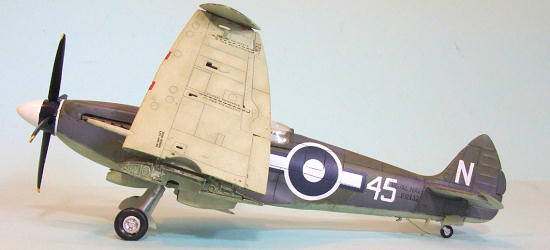
Airfix 1/48 Seafire XV/XVII
| KIT #: | 5117/6102 |
| PRICE: | $22.99/29.99 |
| DECALS: | |
| REVIEWER: | Tom Cleaver |
| NOTES: | Kitbash to create Seafire XV |

| HISTORY |
 elevators and broad-chord
rudder of the Spitfire VIII.
The first 50 aircraft built by Cunliffe-Owen had the
A-frame arrestor hook used on the previous Seafires, as well as the stiff
landing gear associated with those Seafires.
The result was a failure.
The Griffon engine rotated in the opposite direction to
the Merlin, though the airframe was still “bent” for the Merlin’s torque; on
takeoff, the Seafire XV had a pronounced swing to the right, which could and did
result in aircraft actually hitting the island of the aircraft carrier they were
attempting to launch from.
Pilots were told not to give the airplane full throttle
on takeoff, and it was impossible to use the RATOG due to the swing.
Additionally, the airplane bounced horribly on landing
and with the additional weight in the nose of the new engine, since the gear was
unchanged from that used by the lighter-weight versions; it invariably ended up
either tail up with the propeller blades shattered, or upside down, if the
landing was anything less than perfect and even then ship motion could bring on
disaster regardless.
These aircraft went aboard HMS
Implacable with 1801 Squadron just before the end of the
war, but were quickly declared completely unsuitable for carrier operation.
elevators and broad-chord
rudder of the Spitfire VIII.
The first 50 aircraft built by Cunliffe-Owen had the
A-frame arrestor hook used on the previous Seafires, as well as the stiff
landing gear associated with those Seafires.
The result was a failure.
The Griffon engine rotated in the opposite direction to
the Merlin, though the airframe was still “bent” for the Merlin’s torque; on
takeoff, the Seafire XV had a pronounced swing to the right, which could and did
result in aircraft actually hitting the island of the aircraft carrier they were
attempting to launch from.
Pilots were told not to give the airplane full throttle
on takeoff, and it was impossible to use the RATOG due to the swing.
Additionally, the airplane bounced horribly on landing
and with the additional weight in the nose of the new engine, since the gear was
unchanged from that used by the lighter-weight versions; it invariably ended up
either tail up with the propeller blades shattered, or upside down, if the
landing was anything less than perfect and even then ship motion could bring on
disaster regardless.
These aircraft went aboard HMS
Implacable with 1801 Squadron just before the end of the
war, but were quickly declared completely unsuitable for carrier operation.
The rest of the 340 Seafire XVs were modified with a
stinger hook at the extreme tail which helped keep the airplane from bouncing
over the safety barrier on landing, and featured a greatly enlarged rudder which
helped with the takeoff problems, but the landing problems which were due to the
stiff oleos were never really solved.
Seafire XVs were provided to the Royal Canadian Navy for
operation by 803 Squadron aboard HMCS Bonaventure.
Other Seafire XVs were transferred to the French
Aeronavale in 1950, where they served
until 1953.
 The Seafire XVII appeared in the summer of 1945, and
went far to solve the problems of the Seafire XV, most notably by changing the
landing gear to a long-stroke soft oleo designed for a higher-weight airplane
with a lower rebound ratio, which tamed the landing problems.
The Seafire XVII was the first Seafire to be really
comfortable aboard an aircraft carrier, though the entire structure was still
much too light and fragile for prolonged carrier operation without damaging the
airframe.
The aircraft featured the cut-down rear fuselage of later-mark
Spitfires, with a 33-gallon fuel tank immediately behind the cockpit, and a
bubble canopy that differed from that used on Spitfires by having a rounded vee-shaped
windshield.
This was disliked because rain could seriously reduce visibility;
it was suggested that the standard bubble canopy with the traditional windshield
be fitted, but this was not done.
Additionally the Seafire XVII featured a stronger main
spar which allowed it to carry increased underwing fule tanks and ordnance
compared with previous marks.
The airplane could carry two 22 gallon “slipper” tanks
underwing as well as eight Rps in four twin-rocket racks, as well as a 50-gallon
drop tank on the lower fuselage centerline.
The 232 Seafire XVIIs built (212 by
The Seafire XVII appeared in the summer of 1945, and
went far to solve the problems of the Seafire XV, most notably by changing the
landing gear to a long-stroke soft oleo designed for a higher-weight airplane
with a lower rebound ratio, which tamed the landing problems.
The Seafire XVII was the first Seafire to be really
comfortable aboard an aircraft carrier, though the entire structure was still
much too light and fragile for prolonged carrier operation without damaging the
airframe.
The aircraft featured the cut-down rear fuselage of later-mark
Spitfires, with a 33-gallon fuel tank immediately behind the cockpit, and a
bubble canopy that differed from that used on Spitfires by having a rounded vee-shaped
windshield.
This was disliked because rain could seriously reduce visibility;
it was suggested that the standard bubble canopy with the traditional windshield
be fitted, but this was not done.
Additionally the Seafire XVII featured a stronger main
spar which allowed it to carry increased underwing fule tanks and ordnance
compared with previous marks.
The airplane could carry two 22 gallon “slipper” tanks
underwing as well as eight Rps in four twin-rocket racks, as well as a 50-gallon
drop tank on the lower fuselage centerline.
The 232 Seafire XVIIs built (212 by
Seafire XV PR503 was restored to flying status in 2010
in the United States, and Seafire XVII SX336 was restored to flight in Great
Britaain in 2007, suffering a gear-up landing accident in 2011, which is
expected to be repaired by 2013.
| THE KITS |
The Spitfire XVII kit comes with two complete sets of wings, one in the extended configuration, and one in the folded configuration. Given how close the two Airfix kits are, it is a relatively simple kit-bash to use one of the two Seafire XVII wings with the Spitfire XII kit to create a Seafire XV.
| CONSTRUCTION |
 Since I wanted to do two complete kits, there were some
compromises to be made, the major one being that it would only be possible to
build an early Seafire XV, since I would need the larger rudder and the tail
stinger hook for the Seafire XVII build.
Since I wanted to do two complete kits, there were some
compromises to be made, the major one being that it would only be possible to
build an early Seafire XV, since I would need the larger rudder and the tail
stinger hook for the Seafire XVII build.
The kitbash is fairly simple, if one has some leftover
Spitfire parts in the spares box.
What is needed is a larger carburetor intake than is
provided in the Spitfire XII kit, and a second radiator.
I had the larger carburetor intake left over from my
Spitfire XIV conversion, and a spare radiator from the unbuilt Airfix Seafire
The Seafire XVII kit was assembled per the instructions,
without encountering any problems.
I did however make a mistake in assuming that the entire
cockpit was painted black.
In fact, the Seafire XVII was the last Seafire with a
green cockpit interior,
 though the upper sides were painted black.
This mistake is an example of Failure To Do Proper
Research. (The Airfix instructions are correct in this regard as they are
based on the unrestored cockpit of the Seafire F.17 at the FAA museum. Ed)
I solved the problem (after it was too late to go in and repaint
things) by not opening the side flap, limiting the view of the cockpit interior.
though the upper sides were painted black.
This mistake is an example of Failure To Do Proper
Research. (The Airfix instructions are correct in this regard as they are
based on the unrestored cockpit of the Seafire F.17 at the FAA museum. Ed)
I solved the problem (after it was too late to go in and repaint
things) by not opening the side flap, limiting the view of the cockpit interior.
The propeller blades were re-shaped to look like those
for the two different types.
I studied photos to see that the Seafire XV has a
different, narrower blade shape with more symmetrical tips than does the Seafire
XVII, which is closer to that provided in the kit if the tips are reshaped.
I used exhausts from the Spitfire spares box for the Seafire XV; I believe these came from an Airfix Seafire 46/47 kit originally, and they had to be backed with plastic plugs so they could stick out far enough.
| COLORS & MARKINGS |
The Seafire XV was painted in the wartime camouflage
scheme of Dark Slate Grey and Extra Dark Sea Grey on the upper surfaces with Sky
lower surfaces, using Xtracrylix paints applied freehand after the model was
suitably pre-shaded with flat black along the panel lines.
The prop spinner was painted white and Insignia Blue
using Tamiya paints. The Seafire XVII spinner was
 painted red by a guess looking
at the single black and white photo I had available, a choice later confirmed
when I saw photos of another kit done in these markings over at
Britmodeller.com.
painted red by a guess looking
at the single black and white photo I had available, a choice later confirmed
when I saw photos of another kit done in these markings over at
Britmodeller.com.
The Seafire XVII was painted in the postwar scheme of
Extra Dark Sea Grey on the upper wing and horizontal stabilizer and the upper
spine of the fuselage, with the rest in Sky.
Again, Xtracrylix paints were used, but this time were
masked off.
The Extra Dark Sea Grey being applied first, then masked, with
the Sky then applied.
The Seafire XV was marked using decals from the Decal
Dungeon, primarily from old Aeromaster Fleet Air Arm sheets for the Corsair and
Hellcat, with the fuselage national insignia coming from a Grand Phoenix Firefly
I sheet, to do one of the Seafire Xvs assigned to HMS
Implacable in 1945.
The Seafire XVII was marked as an airplane from 1832
Squadron based at Brawdy around 1949, done from a photo found on the Internet.
The serials and the side number were pieced together
from the kit sheet and from other decal sheets in the dungeon.
| FINAL CONSTRUCTION |

The Seafire XVII canopy was unmasked and the sliding
section glued in the open position.
Landing gear and prop were attached.
I did not weather either model because the available
photos showed the originals to be in clean condition.
| CONCLUSIONS |

June 2012
Review kits courtesy of my wallet.
If you would like your product reviewed fairly and fairly quickly, please contact the editor or see other details in the Note to Contributors.